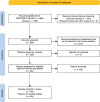Definitions, epidemiology, and outcomes of persistent/chronic critical illness: a scoping review for translation to clinical practice
- PMID: 39731183
- PMCID: PMC11681689
- DOI: 10.1186/s13054-024-05215-4
Definitions, epidemiology, and outcomes of persistent/chronic critical illness: a scoping review for translation to clinical practice
Abstract
Background: Medical advances in intensive care units (ICUs) have resulted in the emergence of a new patient population-those who survive the initial acute phase of critical illness, but require prolonged ICU stays and develop chronic critical symptoms. This condition, often termed Persistent Critical Illness (PerCI) or Chronic Critical Illness (CCI), remains poorly understood and inconsistently reported across studies, resulting in a lack of clinical practice use. This scoping review aims to systematically review and synthesize the existing literature on PerCI/CCI, with a focus on definitions, epidemiology, and outcomes for its translation to clinical practice.
Methods: A scoping review was conducted using MEDLINE and Scopus, adhering to the PRISMA-ScR guidelines. Peer-reviewed original research articles published until May 31, 2024 that described adult PerCI/CCI in their definitions of patient populations, covariates, and outcomes were included. Data on definitions, epidemiology, and outcomes were extracted by a data charting process from eligible studies and synthesized.
Results: Ninety-nine studies met the inclusion criteria. Of these studies, 64 used the term CCI, 18 used PerCI, and 17 used other terms. CCI definitions showed greater variability, while PerCI definitions remained relatively consistent, with an ICU stay ≥ 14 days for CCI and ≥ 10 days for PerCI being the most common. A meta-analysis of the prevalence of PerCI/CCI among the denominators of "all ICU patients", "sepsis", "trauma", and "COVID-19" showed 11% (95% confidence interval 10-12%), 28% (22-34%), 24% (15-33%), and 35% (20-50%), respectively. A meta-analysis of in-hospital mortality was 27% (26-29%) and that of one-year mortality was 45% (32-58%). Meta-analyses of the prevalence of CCI and PerCI showed 17% (16-18%) and 18% (16-20%), respectively, and those for in-hospital mortality were 28% (26-30%) and 26% (24-29%), respectively. Functional outcomes were generally poor, with many survivors requiring long-term care.
Conclusions: This scoping review synthesized many studies on PerCI/CCI, highlighting the serious impact of PerCI/CCI on patients' long-term outcomes. The results obtained underscore the need for consistent terminology with high-quality research for PerCI/CCI. The results obtained provide important information to be used in discussions with patients and families regarding prognosis and care options.
Keywords: Chronic critical illness; Intensive care unit; Persistent critical illness; Scoping review.
© 2024. The Author(s).
Conflict of interest statement
Declarations. Ethics approval and consent to participate: Not applicable. Consent for publication: Not applicable. Competing interests: The authors declare no competing interests.
Figures





References
Publication types
MeSH terms
Associated data
- Actions
LinkOut - more resources
Full Text Sources
Miscellaneous

